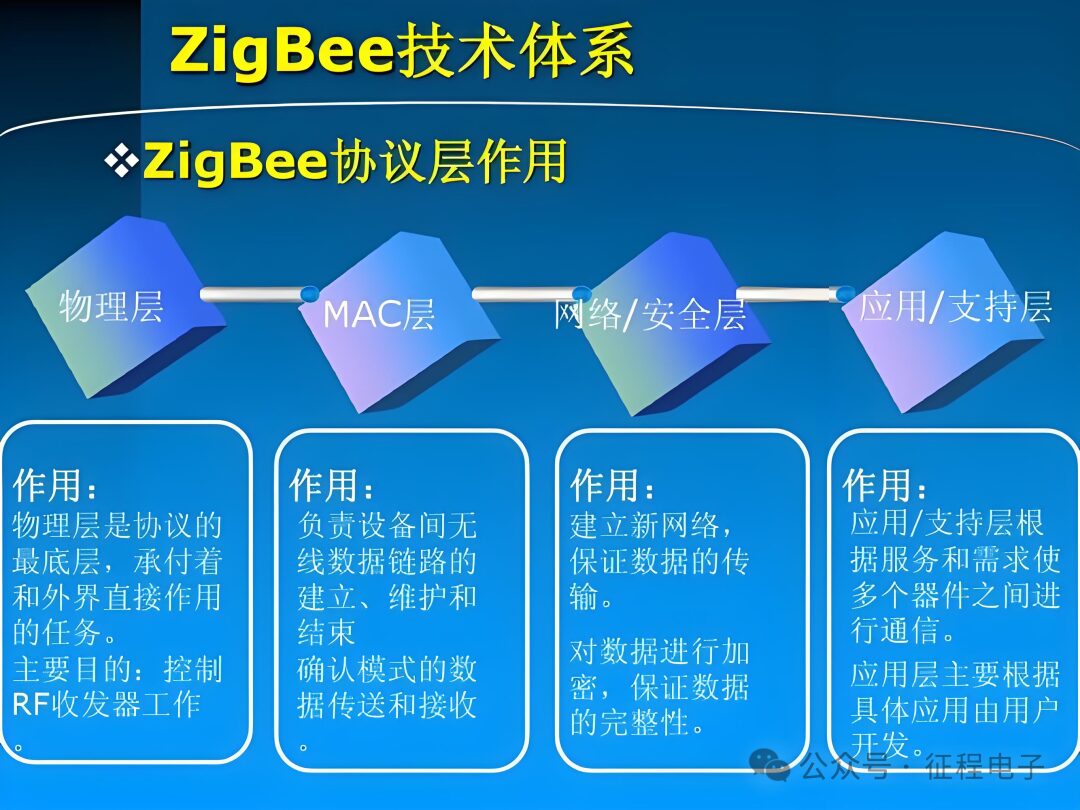Zigbee Protocol is a low-power, low-rate, short-range wireless communication protocol based on the IEEE 802.15.4 standard. It is widely used in fields such as home automation, industrial control, smart homes, and sensor networks, particularly suitable for applications that require short-distance, high-density connections and long-term stable operation between devices. The design goal of the Zigbee protocol is to ensure low-power, reliable communication between devices, allowing for long-term operation without the need for frequent battery replacements.

Characteristics of Zigbee Protocol
1.Low Power Consumption:
oZigbee devices have very low power consumption, making them ideal for small devices and sensors that need to operate for extended periods, such as smart home devices and environmental monitoring equipment. It typically uses a low-power sleep mode, allowing devices to maintain battery life for long periods even when inactive.
2.Low Data Rate:
oZigbee’s transmission rate is low, generally ranging from 20kbps to 250kbps, which is sufficient for many control and sensing applications. The low rate reduces power consumption while also lowering system complexity.
3.Short-Range Communication:
oZigbee typically has a communication distance of 10 to 100 meters, depending on the environment and the device’s power. Despite the short communication range, the coverage can be extended through network topologies such as star, tree, or mesh topologies.
4.Network Topology:
oZigbee supports multiple network topologies, commonly including star topology, tree topology, and mesh topology. Among these, mesh topology is the most commonly used in Zigbee, allowing devices to relay signals through intermediary nodes, thereby extending communication range and enhancing network reliability.
5.Self-Organization and Self-Healing Capabilities:
oZigbee networks support self-organization and self-healing functions. In the network, nodes can automatically discover other nodes and establish connections. If a node fails or cannot communicate, other nodes in the network can automatically reorganize to ensure communication stability.
6.Low Cost:
oZigbee’s implementation is very economical, making it suitable for applications that require a large number of nodes. Compared to other wireless technologies like Bluetooth and Wi-Fi, Zigbee typically has lower hardware and development costs.
7.Security:
oThe Zigbee protocol provides strong security, supporting 128-bit AES encryption to ensure the security of data transmission. It also offers features like authentication and message integrity protection to prevent unauthorized access and data tampering.
8.Support for Large Numbers of Devices:
oThe Zigbee network can support up to approximately 65,000 devices, making it very suitable for large-scale IoT applications such as smart homes, smart cities, and industrial automation.
Working Principle of Zigbee Protocol
The Zigbee protocol stack typically consists of four main layers:

1.Physical Layer (PHY):
oThe physical layer is responsible for transmitting wireless signals, including modulation, demodulation, and transmission of data. Zigbee typically operates in the 2.4GHz frequency band but also supports 868MHz (Europe) and 915MHz (USA) bands.
2.Media Access Control Layer (MAC):
oThe MAC layer controls data access and transmission. It manages channel access and queuing mechanisms for data transmission in the network. Zigbee uses CSMA/CA (Carrier Sense Multiple Access/Collision Avoidance) mechanisms to avoid data collisions.
3.Network Layer (NWK):
oThe network layer is responsible for managing network topology, routing, and selecting paths for data transmission. It supports various network topologies and ensures data can be transmitted to target devices through routing protocols.
4.Application Layer (APL):
oThe application layer defines how to build specific application protocols, such as home automation, industrial control, health monitoring, etc. It supports communication between devices and the exchange of control commands.
Zigbee Network Topologies
Zigbee protocol supports three main network topologies: star topology, tree topology, and mesh topology.
1.Star Topology:
oIn star topology, all devices connect directly to a central coordinator, which manages the network and communication. Although the topology is simple, if the coordinator fails, the entire network will cease to function.
2.Tree Topology:
oTree topology is a hierarchical network structure where devices connect through parent and child nodes to form a tree-like structure. It is suitable for larger networks and can provide better scalability but may increase latency due to the distance between nodes.
3.Mesh Topology:
oMesh topology is the most common form in Zigbee. Each device can act as a relay node, receiving and forwarding data. This allows devices to communicate with each other through multiple paths, enhancing network reliability and coverage. Even if some devices fail, data can still be transmitted to the destination through other paths.
Applications of Zigbee Protocol
Zigbee protocol is widely used in many fields, especially in scenarios that require low power consumption and long operating times. Here are some typical applications:

1.Smart Homes:
oZigbee is widely used in smart home devices such as smart light bulbs, smart locks, smart thermostats, and smart curtains. It enables various devices in the home to be controlled and monitored through a wireless network, enhancing the living experience.
2.Energy Management:
oIn applications like smart grids, smart meters, and energy monitoring, Zigbee can be used for remote collection of energy data and controlling the operation of devices. With Zigbee devices, users can view energy consumption data in real-time, allowing for better management of electricity usage.
3.Industrial Automation:
oZigbee is also widely used in industrial control and automation systems. For example, Zigbee can be used to monitor production equipment, collect sensor data, conduct environmental monitoring (such as temperature and humidity), and enable remote control operations.
4.Health Monitoring:
oZigbee can also be applied in health monitoring devices, such as remote blood glucose monitors, smart health bands, and sleep monitors. These devices can transmit data to cloud platforms or smartphones via Zigbee, enabling real-time tracking and analysis of health data.
5.Smart Cities:
oZigbee also plays an important role in smart cities, such as for smart streetlight control, smart parking systems, and environmental monitoring. Through Zigbee, automated and intelligent management of urban infrastructure can be achieved.
6.Agricultural IoT:
oZigbee can be used in agriculture for environmental monitoring and irrigation control. For example, soil moisture sensors and weather stations can transmit data to a central system via Zigbee networks, helping farmers optimize irrigation plans and improve agricultural yields and resource efficiency.
Advantages and Disadvantages of Zigbee
Advantages:
·Low Power Consumption: Zigbee devices have very low power consumption, suitable for long-term operation, and can rely on battery power for extended periods.
·Large-Scale Network Support: Zigbee can support up to 65,000 devices, making it very suitable for large-scale IoT applications.
·Self-Organization and Self-Healing Features: Zigbee supports automatic network joining and fault self-repair, enhancing network reliability.
·Security: Provides 128-bit AES encryption to ensure data transmission security.
·Low Cost: Hardware and deployment costs are low, making it suitable for large-scale IoT applications.
Disadvantages:
·Low Data Rate: Zigbee’s data transmission rate is low (up to 250kbps), making it unsuitable for applications requiring high data throughput.
·Limited Communication Range: The communication range of Zigbee is generally between 10 to 100 meters. Although coverage can be extended through mesh networks, the effective communication distance of a single device is relatively short.
·Not Suitable for Real-Time Applications: Due to its low rate and some latency, Zigbee is not suitable for applications that require extremely high real-time performance.
Conclusion
The Zigbee protocol, with its low power consumption, low cost, and reliable self-organization and self-healing capabilities, has become an important communication technology in the Internet of Things. It has been widely applied in various fields such as smart homes, industrial automation, and energy management. Despite its low rate and limited scope, its unique advantages make it occupy an important position in many low-power, wide-area IoT applications.